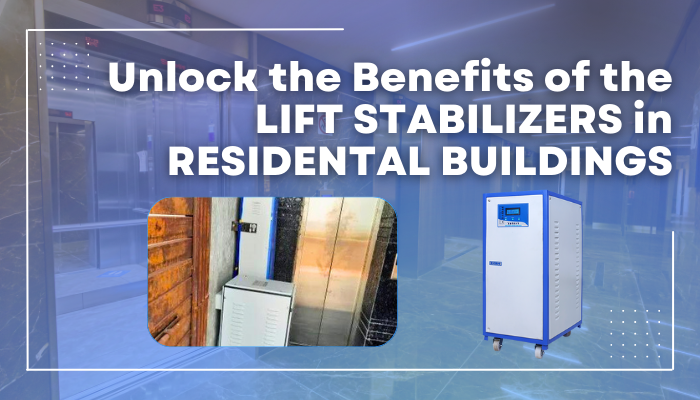Ever wondered why some lifts in buildings feel smoother and more stable than others? Well, the secret often lies in a little thing called a lift stabilizer. In this comprehensive guide, we’re going to know what’s behind these devices and why they’re an absolute game-changer for both residential and commercial buildings.
A significant highlight mentioned here is the servo voltage stabilizer in India, a critical component ensuring that lifts operate seamlessly amidst the country’s fluctuating power supply. Whether you’re looking to clarify the mechanics of modern buildings or simply curious about how these systems work, you’re in the right place. Let’s uncover the layers behind lift stabilizers and the pivotal role of servo voltage stabilizers in enhancing their functionality and reliability.
The Magic Behind Lift Stabilizers: A Simplified Exploration
Ever stepped into a lift and felt your stomach drop as it zoomed up or down? That’s where lift stabilizers come into play, ensuring your ride is as smooth as a Bollywood dance sequence. These clever devices are engineered to counteract the forces that cause lifts to sway or jolt, providing a stable and comfortable experience for users. But the benefits go way beyond just comfort. Let’s dive deeper into the world of lift stabilizers and uncover their significant advantages in residential and commercial buildings.
1. Enhanced Safety: The Top Priority
Safety is important, especially when it comes to vertical transportation in buildings. Lift stabilizers contribute significantly to the safety of elevators by minimizing the risk of malfunctions. They ensure the lift operates smoothly, reducing wear and tear on mechanical components, which can prevent potential accidents. In a country like India, where safety standards are increasingly prioritized, incorporating lift stabilizers in building designs is a step toward safeguarding the well-being of its occupants.
2. Improved Comfort: No More Bumpy Rides
Imagine gliding effortlessly between floors, barely noticing the movement – that’s the level of comfort lift stabilizers provide. They reduce vibrations and noise, making elevator rides more pleasant for residents and visitors alike. This is particularly beneficial in commercial buildings, where creating a positive impression on clients and customers can make a big difference.
3. Energy Efficiency: Saving Power, Saving Costs
In an era where energy conservation is key, lift stabilizers shine brightly. By optimizing the lift’s operation, they can significantly reduce energy consumption. This is because a smoother operation requires less power, leading to lower electricity bills. For buildings aiming for green certification or simply looking to cut costs, incorporating lift stabilizers is a smart move.
4. Extended Lifespan of Elevators: A Long-Term Investment
Regular wear and tear can take its toll on elevators, leading to costly repairs and replacements. However, with lift stabilizers, the strain on cables, motors, and other critical components is greatly reduced. This prolongation of the elevator’s lifespan means a better return on investment for building owners, making lift stabilizers a wise choice for both new constructions and existing structures looking to upgrade.
5. Reduced Maintenance Costs: Keeping Expenses Down
With fewer vibrations and less strain on mechanical parts, elevators equipped with lift stabilizers require less frequent maintenance. This not only saves money over time but also minimizes the inconvenience of having elevators out of service for repairs. For commercial buildings, in particular, where uptime is crucial, this advantage cannot be overstated. Additionally, the longevity of elevator components is significantly enhanced, further driving down long-term capital expenditure on parts and labor.
In a country like India, where economic efficiency is paramount, the cost savings from reduced maintenance can be allocated to other essential building upgrades or amenities, improving overall building value. The reliability provided by lift stabilizers also translates into higher tenant satisfaction and retention rates, a key factor for commercial success.
By ensuring elevators are operational when needed most, businesses can avoid the negative impacts of service disruptions, maintaining a positive image and operational continuity. This strategic investment in lift stabilizers ultimately contributes to a more robust bottom line by cutting unnecessary costs and fostering a more attractive commercial environment.
Making the Case for Lift Stabilizers in Indian Buildings
India’s urban landscape is rapidly evolving, with residential and commercial buildings reaching new heights—literally. As these structures become taller and more sophisticated, the role of lift stabilizers becomes increasingly important. Not only do they enhance the quality of life for residents and workers by ensuring smooth and reliable elevator operations, but they also contribute significantly to the building’s overall efficiency and safety standards.
In the context of India’s unique power challenges, the integration of technologies like servo voltage stabilizers within lift systems is pivotal. These devices safeguard against the frequent power fluctuations and surges that are common in many parts of the country, thereby preventing damage to the elevator’s electrical components and reducing the risk of operational failures.
Furthermore, as the nation pushes towards modernization and sustainability, lift stabilizers are becoming critical in meeting these objectives. They support the creation of smarter, safer, and more resilient urban habitats, aligning with India’s vision for its future cities. By improving energy efficiency, reducing maintenance needs, and enhancing user experience, lift stabilizers play a crucial role in the development of India’s architectural ambitions, making them an indispensable part of the country’s rapidly transforming skyline.
Conclusion: Elevating the Elevator Experience
In wrapping up, lift stabilizers aren’t just a technical add-on; they’re an essential component that brings a myriad of benefits to the table. From ensuring safety and comfort to saving energy and reducing maintenance costs, the advantages are clear. For Indian students and young engineers looking into the future of building technologies, understanding the role and impact of lift stabilizers is invaluable.
As India continues to grow and modernize its infrastructure, the adoption of such technologies will play a crucial role in shaping safe, efficient, and sustainable urban environments. So, the next time you step into an elevator, remember the unsung hero—the lift stabilizer—that’s making your journey smooth and secure.


